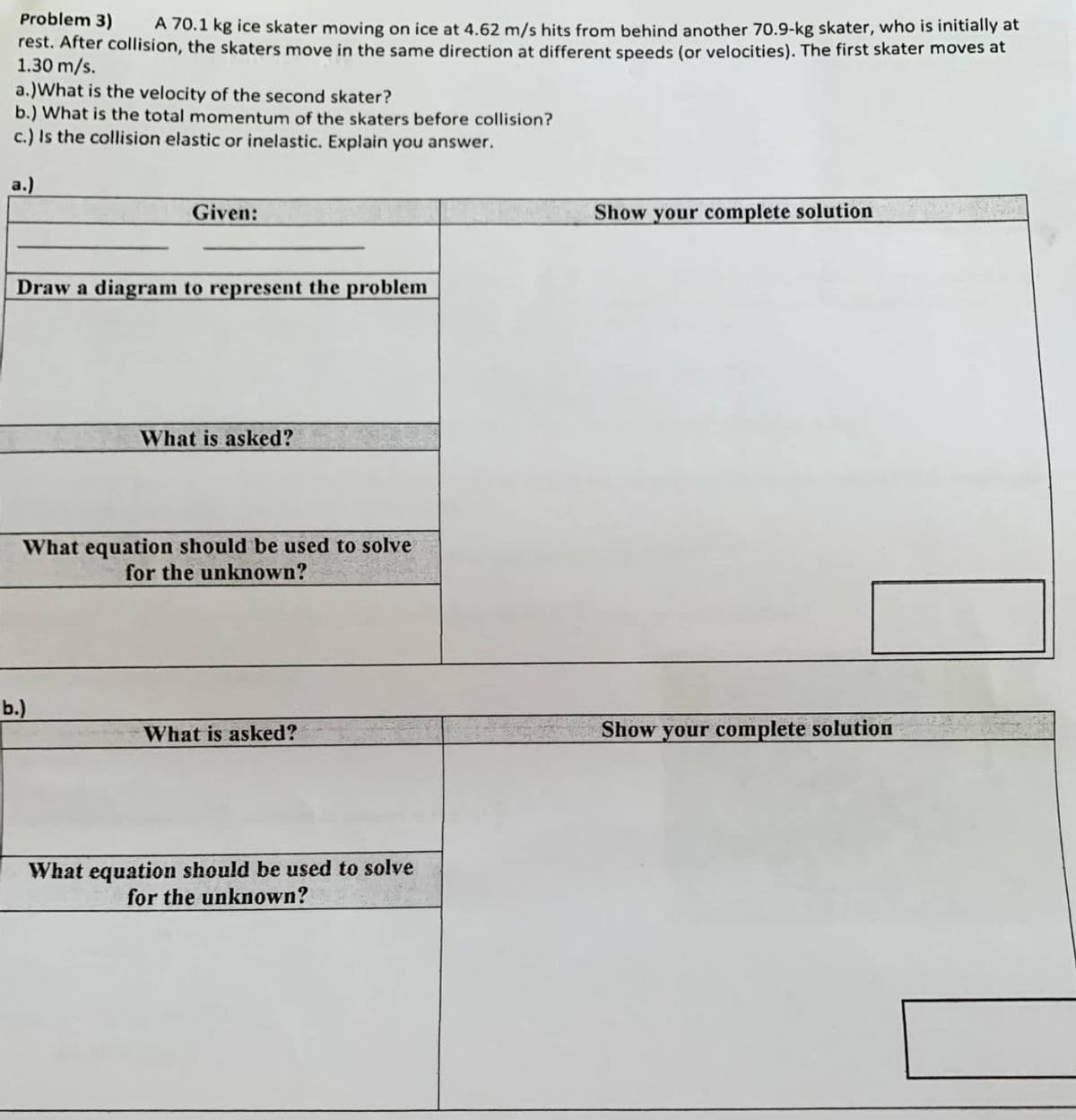Problem 3) A 70.1 kg ice skater moving on ice at 4.62 m/s hits from behind another 70.9-kg skater, who is initially at rest. After collision, the skaters move in the same direction at different speeds (or velocities). The first skater moves at 1.30 m/s. a.)What is the velocity of the second skater? b.) What is the total momentum of the skaters before collision? c.) Is the collision elastic or inelastic. Explain you answer. а.) Given: Show your complete solution Draw a diagram to represent the problem What is asked? What equation should be used to solve for the unknown? b.) What is asked? Show your complete solution What equation should be used to solve for the unknown?
Problem 3) A 70.1 kg ice skater moving on ice at 4.62 m/s hits from behind another 70.9-kg skater, who is initially at rest. After collision, the skaters move in the same direction at different speeds (or velocities). The first skater moves at 1.30 m/s. a.)What is the velocity of the second skater? b.) What is the total momentum of the skaters before collision? c.) Is the collision elastic or inelastic. Explain you answer. а.) Given: Show your complete solution Draw a diagram to represent the problem What is asked? What equation should be used to solve for the unknown? b.) What is asked? Show your complete solution What equation should be used to solve for the unknown?
Physics for Scientists and Engineers, Technology Update (No access codes included)
9th Edition
ISBN:9781305116399
Author:Raymond A. Serway, John W. Jewett
Publisher:Raymond A. Serway, John W. Jewett
Chapter9: Linear Momentum And Collisions
Section: Chapter Questions
Problem 9.91AP: A 2.00-g particle moving at 8.00 m/s makes a perfectly elastic head-on collision with a resting...
Related questions
Question
Answer the following problem.

Transcribed Image Text:Problem 3)
A 70.1 kg ice skater moving on ice at 4.62 m/s hits from behind another 70.9-kg skater, who is initially at
rest. After collision, the skaters move in the same direction at different speeds (or velocities). The first skater moves at
1.30 m/s.
a.)What is the velocity of the second skater?
b.) What is the total momentum of the skaters before collision?
c.) Is the collision elastic or inelastic. Explain you answer.
a.)
Given:
Show your complete solution
Draw a diagram to represent the problem
What is asked?
What equation should be used to solve
for the unknown?
b.)
What is asked?
Show your complete solution
What equation should be used to solve
for the unknown?
Expert Solution
This question has been solved!
Explore an expertly crafted, step-by-step solution for a thorough understanding of key concepts.
This is a popular solution!
Trending now
This is a popular solution!
Step by step
Solved in 2 steps with 2 images

Knowledge Booster
Learn more about
Need a deep-dive on the concept behind this application? Look no further. Learn more about this topic, physics and related others by exploring similar questions and additional content below.Recommended textbooks for you

Physics for Scientists and Engineers, Technology …
Physics
ISBN:
9781305116399
Author:
Raymond A. Serway, John W. Jewett
Publisher:
Cengage Learning

College Physics
Physics
ISBN:
9781285737027
Author:
Raymond A. Serway, Chris Vuille
Publisher:
Cengage Learning

Physics for Scientists and Engineers with Modern …
Physics
ISBN:
9781337553292
Author:
Raymond A. Serway, John W. Jewett
Publisher:
Cengage Learning

Physics for Scientists and Engineers, Technology …
Physics
ISBN:
9781305116399
Author:
Raymond A. Serway, John W. Jewett
Publisher:
Cengage Learning

College Physics
Physics
ISBN:
9781285737027
Author:
Raymond A. Serway, Chris Vuille
Publisher:
Cengage Learning

Physics for Scientists and Engineers with Modern …
Physics
ISBN:
9781337553292
Author:
Raymond A. Serway, John W. Jewett
Publisher:
Cengage Learning

Physics for Scientists and Engineers
Physics
ISBN:
9781337553278
Author:
Raymond A. Serway, John W. Jewett
Publisher:
Cengage Learning

Principles of Physics: A Calculus-Based Text
Physics
ISBN:
9781133104261
Author:
Raymond A. Serway, John W. Jewett
Publisher:
Cengage Learning

Glencoe Physics: Principles and Problems, Student…
Physics
ISBN:
9780078807213
Author:
Paul W. Zitzewitz
Publisher:
Glencoe/McGraw-Hill